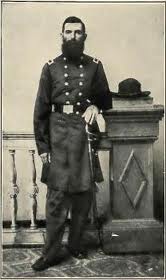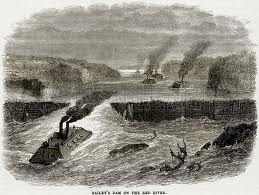 Bailey’s Red River Rescue, saved a Union Army and he became “Commissary” Banks’ hero. General Nathaniel P. Banks or just “Commissary” Banks, was one of the most inept Generals of the Civil War. A Lincoln appointee, with no military training, his failures in the field outweighed any fame that he garnered by the Confederate surrender at Port Hudson. The Red River Campaign in the Spring of 1864, was considered by Bank’s superior Ulysses S. Grant, a waste of valuable manpower. General Grant wanted Banks to drive east to capture Mobile, Alabama, as part of a series of strategic offensives.
Bailey’s Red River Rescue, saved a Union Army and he became “Commissary” Banks’ hero. General Nathaniel P. Banks or just “Commissary” Banks, was one of the most inept Generals of the Civil War. A Lincoln appointee, with no military training, his failures in the field outweighed any fame that he garnered by the Confederate surrender at Port Hudson. The Red River Campaign in the Spring of 1864, was considered by Bank’s superior Ulysses S. Grant, a waste of valuable manpower. General Grant wanted Banks to drive east to capture Mobile, Alabama, as part of a series of strategic offensives.
General Halleck came up with another plan, to march 30,000 troops along the Red River and capture Shreveport. Banks’ Army was routed at the Battle of Mansfield and retreated to Alexandria, the army remained demoralized in Banks’ command. Admiral Porter had joined the Red River Campaign to load captured Confederate cotton reserves and Banks had allowed rich “white gold” speculators to come along, but Porter’s fleet had become trapped above the falls at Alexandria. “Commissary” Banks was on the verge of the greatest of all his military humiliations and needed a miracle in order to prevail.
 Joseph Bailey, a native of Ohio, was born in 1825 and held a degree in Civil Engineering, with civilian experience in lumbering. At the beginning of the Civil War he served as Chief of Engineers for the City of New Orleans, under General Butler. Promoted to Major in 1863, Bailey supported engineering efforts under “Commissary” Banks at Port Hudson.
Joseph Bailey, a native of Ohio, was born in 1825 and held a degree in Civil Engineering, with civilian experience in lumbering. At the beginning of the Civil War he served as Chief of Engineers for the City of New Orleans, under General Butler. Promoted to Major in 1863, Bailey supported engineering efforts under “Commissary” Banks at Port Hudson.
Bailey, who had been promoted to Colonel, accompanied Banks, as an engineering advisor, on the Red River fiasco. When it appeared that “Bobbin Boy’s” Army was doomed, he suggested a novel solution to Admiral Porter, to free his trapped gunboats and return the troops back to the Mississippi River. Bailey suggested building a series dams above the falls, raising the level of the river, then exploding them, releasing an enormous flow, that would float Porter’s crafts, over the falls and back down the Red River. “Commissary” was skeptical, but Porter finally convinced him to chance the daring proposition. Banks was certainly up the creek, without a paddle, what else could he do.
 Bailey, employing his logging background, put 10,000 troopers to work building two wing dams to impede the flow of the Red River and increase its depth from 3 to 6 feet. The soldiers worked on the dams for 8 days and nights, the gun boats were stripped of any excess weight and prepared for their run over the falls and the ensuing rapids. The infantry marched down river hoping that their transportation would survive the watery ordeal. The explosion of the dams created a tremendous rush of water and the gunboats were hurtled over the falls and survived the rapids, the stranded Army was finally saved and the remnants of “Bobbin Boys” Army were returned to the safety of the Mississippi River. Needless to say, this was General Banks last command.
Bailey, employing his logging background, put 10,000 troopers to work building two wing dams to impede the flow of the Red River and increase its depth from 3 to 6 feet. The soldiers worked on the dams for 8 days and nights, the gun boats were stripped of any excess weight and prepared for their run over the falls and the ensuing rapids. The infantry marched down river hoping that their transportation would survive the watery ordeal. The explosion of the dams created a tremendous rush of water and the gunboats were hurtled over the falls and survived the rapids, the stranded Army was finally saved and the remnants of “Bobbin Boys” Army were returned to the safety of the Mississippi River. Needless to say, this was General Banks last command.
As for Bailey, he received a Presentation Sword, a silver vase and a promotion to Brigadier General. Admiral Porter wrote,
“The highest honors that the Government can bestow on Colonel Bailey can never repay him for the service he has rendered the country. He has saved the Union a valuable fleet, worth nearly two million dollars, and he has deprived the enemy of a triumph which would have emboldened them to carry on this war a year or two longer.”
Bailey’s Red River Rescue, transformed the Civil Engineer from Ohio, into “Commissary” Banks’ Hero.
Bummer

